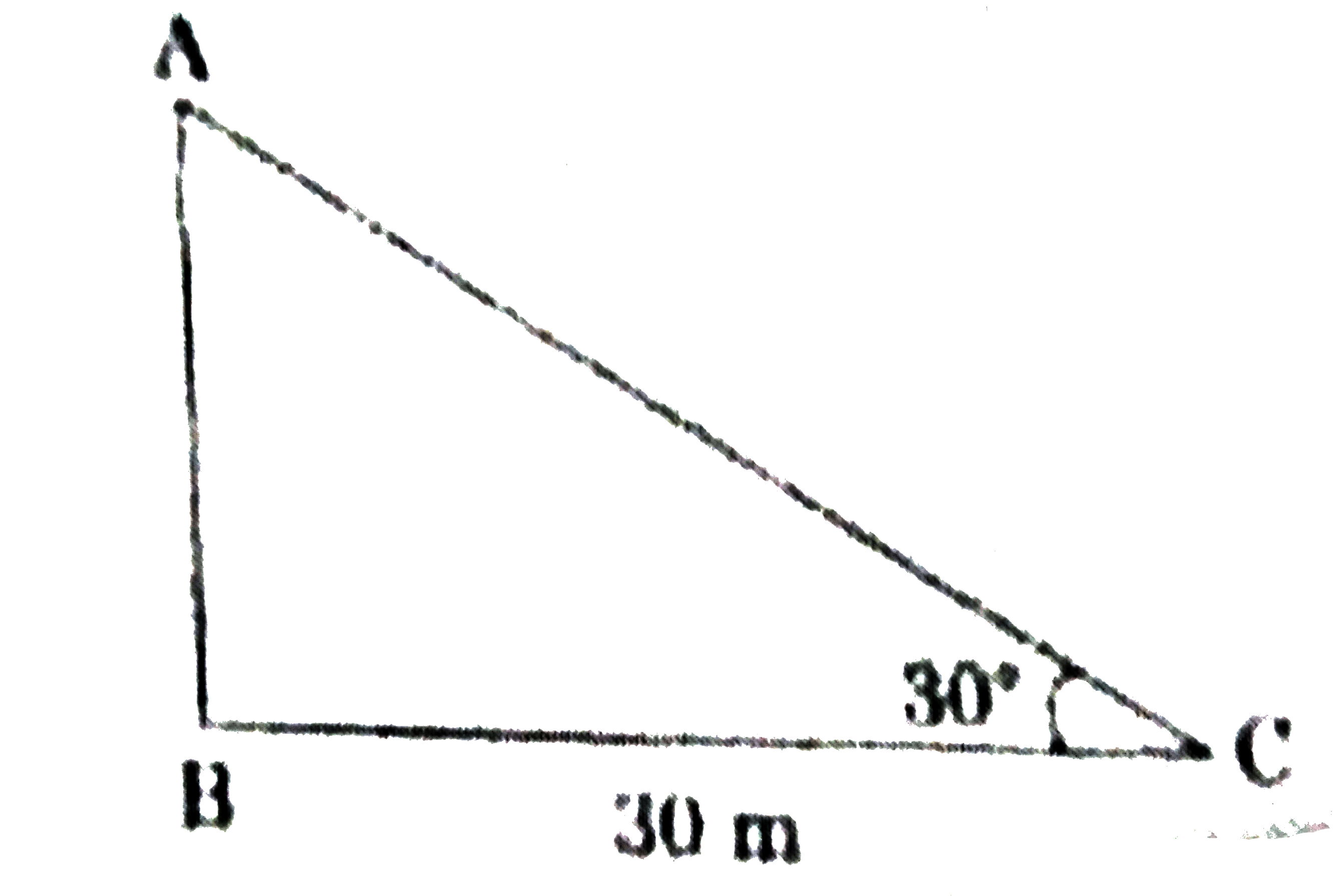The electric pole subtends an angle of 30∘ at a point on the same level as its foot. At a second point 'b' metres above the first, the depression of the foot of the tower is 60∘. The height of the tower (in towers) is equal to
b m
3b m
√3b m
(b/3)m
The correct Answer is:D
To solve the problem, we need to find the height of the electric pole (tower) based on the angles given and the height difference between two points. Let's break down the solution step by step.
Step 1: Understand the problem
We have an electric pole (tower) of height H. At point D, which is at the foot of the tower, the angle of elevation to the top of the tower (point A) is 30∘. At point C, which is b meters above point D, the angle of depression to point D is 60∘.
Step 2: Set up the triangles
1. Triangle BEC: Here, BE is the height difference b (the height from point D to point C), and EC is the horizontal distance from point D to the foot of the tower.
2. Triangle ABD: In this triangle, AB is the height of the tower H, and BD is the same horizontal distance EC.
Step 3: Use trigonometric ratios
1. For triangle BEC:
tan(60∘)=BEEC
Since BE=b and tan(60∘)=√3, we can write:
√3=bEC
Rearranging gives:
EC=b√3(Equation 1)
2. For triangle ABD:
tan(30∘)=ABBD
Here, AB=H and BD=EC. Since tan(30∘)=1√3, we have:
1√3=HEC
Rearranging gives:
H=EC⋅1√3(Equation 2)
Step 4: Substitute Equation 1 into Equation 2
From Equation 1, we know:
EC=b√3
Substituting this into Equation 2:
H=(b√3)⋅1√3=b3
Conclusion
The height of the tower H is:
H=b3 meters
We have an electric pole (tower) of height H. At point D, which is at the foot of the tower, the angle of elevation to the top of the tower (point A) is 30∘. At point C, which is b meters above point D, the angle of depression to point D is 60∘.
1. Triangle BEC: Here, BE is the height difference b (the height from point D to point C), and EC is the horizontal distance from point D to the foot of the tower.
2. Triangle ABD: In this triangle, AB is the height of the tower H, and BD is the same horizontal distance EC.
1. For triangle BEC:
tan(60∘)=BEEC
Since BE=b and tan(60∘)=√3, we can write:
√3=bEC
Rearranging gives:
EC=b√3(Equation 1)
tan(30∘)=ABBD
Here, AB=H and BD=EC. Since tan(30∘)=1√3, we have:
1√3=HEC
Rearranging gives:
H=EC⋅1√3(Equation 2)
From Equation 1, we know:
EC=b√3
Substituting this into Equation 2:
H=(b√3)⋅1√3=b3
The height of the tower H is:
H=b3 meters
Similar Questions
A tower subtends an angle of 30o at a point on the same level as its foot. At a second point h metres above the first, the depression of the foot of the tower is 60o. The height of the tower is
View SolutionA tower subtends an angle of 30∘ at a point on the same level as the foot of the tower. At a second point h meter above the first, the depression of the foot of the tower is 60∘. The horizontal distance of the tower from the point is
View SolutionA tower subtends an angle α at a point on the same level as the root of the tower and at a second point, b meters above the first, the angle of depression of the foot of the tower is β. The height of the tower is
View SolutionA tower subtends an angle 75∘ at a point on the same level as the foot of the tower and at another point, 10 meters above the first, the angle of depression of the foot of the tower is 15∘. The height of the tower is (in meters)
View SolutionA tower subtends an angle of 60∘ at a point on the plane passing through its foot and at a point 20 m vertically above the first point, the angle of depression of the foot of tower is 45∘. Find the height of the tower.
View SolutionA vertical tower subtends an angle of 60∘ at a point on the same level as the foot of the tower. On moving 100 m further from the first point in line with the tower, it subtends an angle of 30∘ at the point. If the height of the tower is Hm, then the value of H25√3 (in meters) is
View SolutionFrom the top of a 7 m high building, the angle of elevation of the top of a tower is 60° and the angle of depression of the foot of the tower is 30°. Find the height of the tower.
View SolutionThe angle of elevation of the top of a tower from a point on the ground, which is 30m away from the foot of the tower is 30∘ . Find the height of the tower.
View SolutionThe angle elevation of the top of a tower from a point C on the ground. Which is 30 m away from the foot of the tower is 30∘ . Find the height of the tower.

View SolutionThe angle of elevation of the top of a tower from a point on the ground, which is 40 m away from the foot of the tower is 30∘. Find the height of the tower.
View Solution
